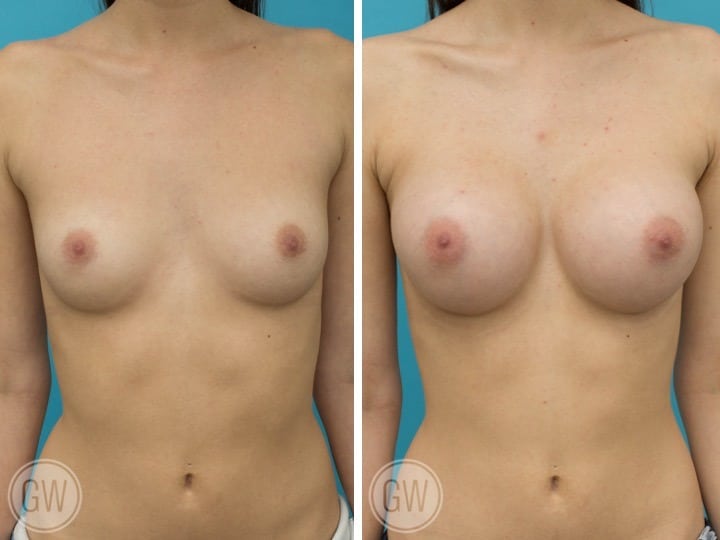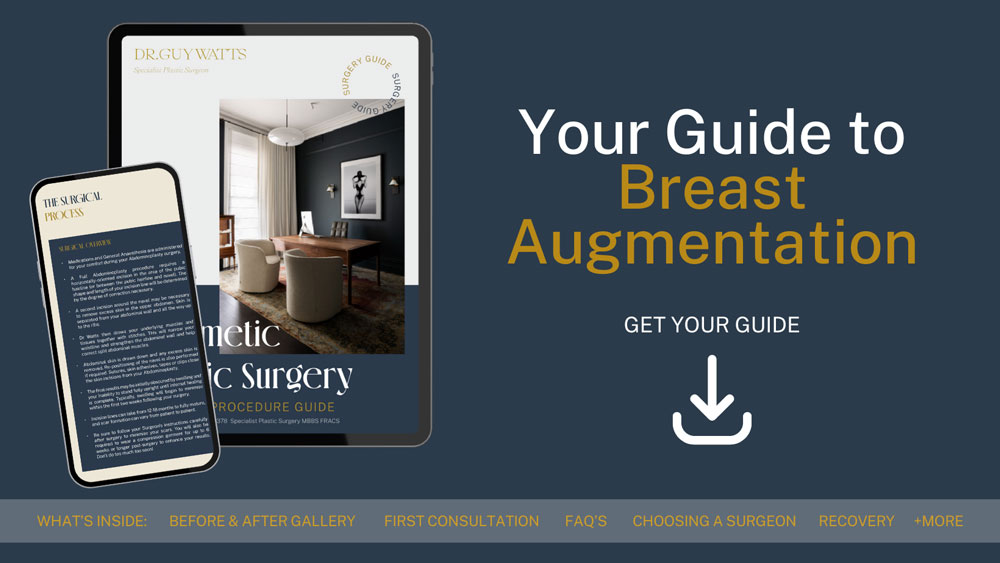
10 Jul Breast Augmentation Size Chart – Implant Sizes and Bra Cup Sizes
Dr Guy Watts, Specialist Plastic & Reconstructive Surgeon in Perth, Western Australia, is dedicated to helping patients achieve balanced, natural-looking breast augmentation results. With years of experience in aesthetic and reconstructive surgery, Dr Watts focuses on providing evidence-based options tailored to each patient’s unique needs. Breast augmentation is more than just increasing breast size; it is about addressing symmetry, proportion, and overall harmony while maintaining a desired aesthetic.
For many individuals, choosing the right implant size can be overwhelming due to the variety of available options. The relationship between implant size and bra cup size is not always straightforward, and factors such as chest width, breast tissue, and implant profile all play a role in achieving the desired outcome. Unlike bra sizing, which varies significantly between brands, implant sizing follows a more standardised approach based on volume and projection.
In this guide, Dr Watts provides a comprehensive, evidence-based overview of breast implant size charts. The goal is to help patients understand the factors influencing implant selection, dispel common misconceptions, and make informed decisions that align with their body proportions and preferences.
Take our quiz, and find out if you are ready for surgery
Understanding Breast Implant Size Charts
Selecting the right breast implant size requires more than simply choosing a cup size. A structured implant size chart helps patients and surgeons determine the most suitable volume, shape, and projection for optimal results. Implant sizing is a critical aspect of the consultation process, ensuring each patient receives a natural and proportionate outcome.
Key Considerations for Implant Sizing:
- Implant Volume (cc): Breast implants are measured in cubic centimetres (cc), typically ranging from 100cc to 800cc or more. The volume of the implant directly influences breast size, but other factors like implant profile and chest width must also be considered.
- Cup Size Estimation: Generally, every 150–200cc corresponds to an increase of about one cup size, though this can vary based on individual chest dimensions, skin characteristics, and existing breast tissue.
- Implant Profile Options: Low, moderate, and high profiles affect how far the breasts project from the chest. High-profile implants provide more projection, while low-profile implants offer a broader base with a more subtle result.
Common Implant Sizes and Their Estimated Cup Equivalents
For those considering breast augmentation, understanding the relationship between implant size and cup size can be beneficial. Implants ranging from 100cc to 200cc typically result in an increase from an A cup to a small B cup. Moving up to 250cc to 300cc, patients may achieve a full B cup to a small C cup. Implants within the 325cc to 375cc range generally correspond to a C cup to a small D cup. A more significant increase can be seen with 400cc to 450cc implants, which typically translate to a full D cup to a small DD cup. Larger implants, such as those between 500cc and 550cc, often lead to a DD cup to a small E cup. Those opting for 600cc to 700cc implants may expect results in the full E cup to F cup range. Finally, 750cc and above typically result in large F cups and beyond.
Important: Bra sizing varies significantly across different brands, so patients should always prioritise proportion and balance rather than aiming for a specific cup size. Dr Watts works closely with patients to assess their anatomy and lifestyle before recommending the most suitable implant size. Also, the end result cup size with depend on the implant chosen and the amount of breast tissue you had to start with.
DOWNLOAD DR WATTS’ GUIDE TO BREAST AUGMENTATION

Choosing the Right Breast Implant Size for Your Body
Achieving a natural, well-balanced result with breast augmentation depends on choosing the right implant size. Dr Guy Watts adopts a personalised approach, carefully considering a patient’s anatomy, lifestyle, and long-term aesthetic goals to determine the most suitable implant size.
Factors Influencing Implant Size Selection
- Chest width and existing breast tissue: A wider chest can accommodate a larger implant, while a narrower frame may require a moderate size to maintain balanced proportions.
- Implant projection: Low, moderate, and high-profile implants influence how much the breasts project forward from the chest. Patients looking for more volume in the upper portion may benefit from a high-profile implant, while those desiring a more understated appearance may opt for a moderate or low-profile implant.
- Skin elasticity and tissue characteristics: The quality of a patient’s skin and existing breast tissue determines how well the body supports the implant over time. Patients with good skin elasticity tend to achieve stable and natural-looking results.
- Lifestyle considerations: Individuals who lead an active lifestyle, such as athletes or those engaging in high-impact activities, may prefer moderately sized implants for greater comfort and practicality in the long term.
Common Myths vs. Facts About Breast Implant Sizing
- Myth: “Larger implants always look better.”
Fact: Balance is more important than size alone. Dr Watts ensures patients receive an implant that complements their body proportions. - Myth: “Cup size is a reliable way to choose implants.”
Fact: Since cup sizes vary significantly between brands, they are not an accurate measure for determining implant size. Surgeons use precise anatomical measurements to select implants instead. - Myth: “I can just pick a celebrity’s implant size.”
Fact: Implant selection must be based on an individual’s unique anatomy rather than external influences.
Pre-Operative Considerations for Breast Augmentation
Before undergoing breast augmentation, patients should carefully evaluate their goals and discuss all options with Dr Guy Watts. A thorough consultation ensures that patients have realistic expectations and understand the factors that contribute to their final result.
Key Pre-Surgery Considerations:
- Defining your goals: Patients should clearly communicate their expectations and discuss their desired breast shape, volume, and projection.
- Assessing lifestyle factors: Individuals who engage in frequent physical activity, such as running or weightlifting, may benefit from moderately sized implants to maintain comfort and ease of movement.
- Planning for recovery: Patients should be prepared to take time off from work and avoid strenuous activities for the recommended recovery period to support proper healing.
- Discussing incision placement and implant positioning: The incision may be placed in the breast fold (inframammary), around the areola (periareolar), or in the armpit (transaxillary), with each option offering unique advantages.
Post-Operative Expectations and Recovery
Recovery is a crucial phase in achieving optimal results. Dr Watts provides comprehensive post-operative care instructions to support healing and reduce complications.
Recovery Timeline:
- First 1-2 Weeks: Patients may experience swelling, tightness, and mild discomfort. A supportive surgical bra is recommended to aid in recovery.
- Weeks 3-6: Bruising and swelling begin to subside. Light activities may be resumed, but strenuous exercise should still be avoided.
- 6-8 Weeks: Most patients can return to normal activities, including exercise, as healing progresses.
- Long-Term: Regular follow-up appointments with Dr Watts ensure lasting results and monitor implant stability.
FAQs about Breast Implant Sizes and Bra Cup Sizes
Final Thoughts: Making an Informed Decision
Breast augmentation is a highly personal decision that requires careful planning and expert guidance. Dr Guy Watts, Specialist Plastic & Reconstructive Surgeon in Perth, is committed to helping patients achieve results that align with their natural proportions and preferences.
If you are considering breast augmentation, schedule a consultation with Dr Guy Watts to explore your options.
For more information, please call (08) 9286 1600.
Further Reading
- Read Dr. Watts’ Blog About How Can I Enlarge My Breasts?
About Dr. Guy Watts – MED0001539378
FRACS (Plas) – Specialist Plastic Surgeon In Perth WA
Dr. Guy Watts is a Specialist Plastic Surgeon (AHPRA MED0001539378) with an extensive career that spans across renowned plastic surgery clinics worldwide. His experience has been honed through invaluable experiences at esteemed establishments such as the New York Eye and Ear Infirmary and the renowned Pitanguy Clinic in Brazil.
Having collaborated with the foremost cosmetic plastic surgeons on a global scale, Dr. Watts has chosen to return to Perth after a 17-year journey of intensive training and invaluable professional experience to bring the latest practices and technology in cosmetic plastic surgery to his patients.
Dr. Watts is a Fellow of the Royal Australasian College of Surgeons (FRACS) and a Member of the Australian Society of Plastic Surgeons (ASPS), Australasian Society of Aesthetic Plastic Surgeons (ASAPS) and the International Society of Aesthetic Plastic Surgeons (ISAPS).
Read about the potential Risks and Complications of Surgery
Read the Patient Information and Resources
About CLINISPA
Clinispa is Dr Watts’ bespoke medical clinic performing Cosmetic Aesthetic treatments. At Clinispa, we offer advanced clinical treatments in a luxurious and calming environment, tailored to support your skin’s health and appearance.
Clinispa aesthetic services are performed by Dr Guy Watts’ nursing professionals, who have a passion for and solid understanding of facial aesthetics.
All Clinispa clients are considered individually, with a personalised treatment plan consisting of advanced scientific approaches to cosmetic aesthetics. We incorporate innovative technologies in conjunction with superiorly formulated skin care.
For more information about the full range of Clinispa Aesthetic of Cosmetic Treatments visit the Clinispa website








Sorry, the comment form is closed at this time.